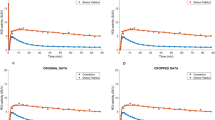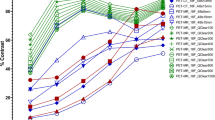Abstract
Aim
The aim of the study was (1) to evaluate the reconstruction strategies with dynamic [\(_{ }^{11}\mathrm C\)]-raclopride human positron emission tomography (PET) studies acquired from ECAT high-resolution research tomograph (HRRT) scanner and (2) to justify for the selected gap-filling method for analytical reconstruction with simulated phantom data.
Methods
A new transradial bicubic interpolation method has been implemented to enable faster analytical 3D-reprojection (3DRP) reconstructions for the ECAT HRRT PET scanner data. The transradial bicubic interpolation method was compared to the other gap-filling methods visually and quantitatively using the numerical Shepp–Logan phantom. The performance of the analytical 3DRP reconstruction method with this new gap-filling method was evaluated in comparison with the iterative statistical methods: ordinary Poisson ordered subsets expectation maximization (OPOSEM) and resolution modeled OPOSEM methods. The image reconstruction strategies were evaluated using human data at different count statistics and consequently at different noise levels. In the assessments, 14 [\(_{ }^{11}\mathrm C\)]-raclopride dynamic PET studies (test–retest studies of 7 healthy subjects) acquired from the HRRT PET scanner were used. Besides the visual comparisons of the methods, we performed regional quantitative evaluations over the cerebellum, caudate and putamen structures. We compared the regional time–activity curves (TACs), areas under the TACs and binding potential (BP\(_{\text {ND}}\)) values.
Results and conclusions
The results showed that the new gap-filling method preserves the linearity of the 3DRP method. Results with the 3DRP after gap-filling method exhibited hardly any dependency on the count statistics (noise levels) in the sinograms while we observed changes in the quantitative results with the EM-based methods for different noise contamination in the data. With this study, we showed that 3DRP with transradial bicubic gap-filling method is feasible for the reconstruction of high-resolution PET data with missing sinogram bins. The calculated intraclass correlation coefficient (ICC) values were similar for all tested methods and validated the test–retest study. The gap-filling and 3DRP method can be used for quantitative PET studies in which high temporal information is crucial and can serve as a reference method for comparison studies of the other reconstruction methods.






Similar content being viewed by others
Notes
See footnote 3.
The study protocol was approved by the Ethics Committee of the Hospital District of Southwestern Finland. The study subjects were given written information about all the relevant issues involved in this study. A written consent was obtained from each subject. This study was performed according to the ethical guidelines given by the Declaration of Helsinki.
References
Yaqub M, Boellaard R, Kropholler MA, Lammertsma AA. Optimization algorithms and weighting factors for analysis of dynamic PET studies. Phys Med Biol. 2006;51(17):4217.
Johansson J, Oikonen V, Teras M. Quantitative brain imaging using the new, fast iterative histogram-mode reconstruction for the HRRT PET scanner. In: IEEE Nuclear Science Symposium Conference Record, vol 5. IEEE; 2007. p. 3463–67
Walker MD. Quantitative dynamic 3D pet scanning of the body and brain using LSO tomographs. Manchester: The University of Manchester; 2009
Walker MD, Asselin M, Julyan PJ, Feldmann M, Talbot P, Jones T, et al. Bias in iterative reconstruction of low-statistics PET data: benefits of a resolution model. Phys Med Biol. 2011;56(4):931.
Kinahan PE, Rogers J. Analytic 3D image reconstruction using all detected events. IEEE Trans Nucl Sci. 1989;36(1):964–8.
de Jong HW, van Velden FH, Kloet RW, Buijs FL, Boellaard R, Lammertsma AA. Performance evaluation of the ECAT HRRT: an LSO-LYSO double layer high resolution, high sensitivity scanner. Phys Med Biol. 2007;52(5):1505.
de Jong HW, Boellaard R, Knoess C, Lenox M, Michel C, Casey M, et al. Correction methods for missing data in sinograms of the HRRT PET scanner. IEEE Trans Nucl Sci. 2003;50(5):1452–6.
van Velden FH, Kloet RW, van Berckel BN, Molthoff CF, Lammertsma AA, Boellaard R. Gap filling strategies for 3-D-FBP reconstructions of high-resolution research tomograph scans. IEEE Trans Med Imaging. 2008;27(7):934–42.
Tuna U, Peltonen S, Ruotsalainen U. Data estimation for the ECAT HRRT sinograms by utilizing the DCT domain. In: IEEE Nuclear Science Symposium Conference Record. IEEE; 2008. p. 5076–80
Tuna U, Peltonen S, Ruotsalainen U. Interpolation for the gap-filling of the HRRT PET sinograms by using the slices in the direction of the radial samples. In: IEEE Nuclear Science Symposium Conference Record. IEEE; 2009. p. 3273–79
Tuna U, Peltonen S, Ruotsalainen U. Gap-filling for the high-resolution PET sinograms with a dedicated DCT-domain filter. IEEE Trans Med Imaging. 2010;29(3):830–9.
Karp J, Muehllehner G, Lewitt R. Constrained Fourier space method for compensation of missing data in emission computed tomography. IEEE Trans Med Imaging. 1988;7(1):21–5.
Tuna U, Johansson J, Ruotsalainen U. Comparison of 3D-RP and 3D-OPOSEM reconstructions of the ECAT HRRT PET data. In: IEEE Nuclear Science Symposium Conference Record. IEEE; 2010. p. 3511–15
Comtat C, Bataille F, Michel C, Jones J, Sibomana M, Janeiro L, et al. OSEM-3D reconstruction strategies for the ECAT HRRT. In: IEEE Nuclear Science Symposium Conference Recoed, vol 6. IEEE; 2004. p. 3492–96
Comtat C, Sureau F, Sibomana M, Hong I, Sjoholm N, Trebossen R. Image based resolution modeling for the HRRT OSEM reconstructions software. In: IEEE Nuclear Science Symposium Conference Recoed. IEEE; 2008. p. 4120–23
Sureau FC, Reader AJ, Comtat C, Leroy C, Ribeiro MJ, Buvat I, et al. Impact of image-space resolution modeling for studies with the high-resolution research tomograph. J Nucl Med. 2008;49(6):1000–8.
Schabel M. 3D Shepp–Logan Phantom. Math-works. 2006
Alakurtti K, Aalto S, Johansson JJ, Någren K, Tuokkola T, Oikonen V, et al. Reproducibility of striatal and thalamic dopamine D2 receptor binding using [11C] raclopride with high-resolution positron emission tomography. J Cereb Blood Flow Metab. 2010;31(1):155–65.
Strother S, Casey M, Hoffman E. Measuring PET scanner sensitivity: relating countrates to image signal-to-noise ratios using noise equivalents counts. IEEE Trans Nucl Sci. 1990;37(2):783–8.
Watson C. New, faster, image-based scatter correction for 3D PET. IEEE Trans Nucl Sci. 2000;47(4):1587–94.
Keys R. Cubic convolution interpolation for digital image processing. IEEE Trans Acoust Speech. 1981;29(6):1153–60.
Loukiala A, Tuna U, Beer S, Jahnke S, Ruotsalainen U. Gap-filling methods for 3D PlanTIS data. Phys Med Biol. 2010;55(20):6125.
Innis RB, Cunningham VJ, Delforge J, Fujita M, Gjedde A, Gunn RN, et al. Consensus nomenclature for in vivo imaging of reversibly binding radioligands. J Cereb Blood Flow Metab. 2007;27(9):1533–9.
Lammertsma AA, Hume SP. Simplified reference tissue model for PET receptor studies. Neuroimage. 1996;4(3):153–8.
Gunn RN, Lammertsma AA, Hume SP, Cunningham VJ. Parametric imaging of ligand-receptor binding in PET using a simplified reference region model. Neuroimage. 1997;6(4):279–87.
Weir JP. Quantifying test-retest reliability using the intraclass correlation coefficient. J Strength Cond Res. 2005;19(1):231–40.
van Velden FH, Kloet RW, van Berckel BN, Lammertsma AA, Boellaard R. Accuracy of 3-dimensional reconstruction algorithms for the high-resolution research tomograph. J Nucl Med. 2009;50(1):72–80.
Johansson J, Teuho J, Linden J, Tuna U, Tolvanen T, Saunavaara V, et al. Image quantification in high-resolution PET assessed with a new anthropomorphic brain phantom. In: IEEE Nuclear Science Symposium Conference Record. IEEE; 2013
Akram M, Tuna U, Solevi P, Rafecas M, Ruotsalainen U. Analytical image reconstruction strategies for AX-PET data. In: IEEE Nuclear Science Symposium Conference Recoed. IEEE; 2011. p. 4244–48
Acknowledgments
The authors thank Prof. Jarmo Hietala, Dr. Mika Teräs, Prof. Juha Rinne and MD. Kati Alakurtti (Turku PET Centre, Turku, Finland) for the test–retest ECAT HRRT data. Moreover, we would like to thank the head of the ECAT HRRT users community, Merence Sibomana for providing us the ECAT HRRT software packages. This work was supported by the Academy of Finland (application number: 129657, Finnish Programme for Centres of Excellence in Research 2006–2011) and by the Graduate School in Electronics, Telecommunication and Automation (GETA), Finland.
Author information
Authors and Affiliations
Corresponding author
Rights and permissions
About this article
Cite this article
Tuna, U., Johansson, J. & Ruotsalainen, U. Evaluation of analytical reconstruction with a new gap-filling method in comparison to iterative reconstruction in [\(_{ }^{11}\mathrm C\)]-raclopride PET studies. Ann Nucl Med 28, 417–429 (2014). https://doi.org/10.1007/s12149-014-0832-y
Received:
Accepted:
Published:
Issue Date:
DOI: https://doi.org/10.1007/s12149-014-0832-y
Keywords
- Area under the curve (AUC)
- Binding potential image ((BPND)-image)
- Brain
- Image reconstruction
- Intraclass correlation coefficient (ICC)
- Nuclear imaging
- Positron emission tomography (PET)
- Quantitative evaluation
- Raclopride
- Reconstruction methods comparison
- Region of interest (ROI)
- Time–activity curve (TAC)
- Transradial bicubic interpolation




